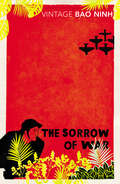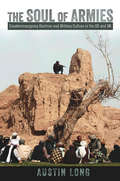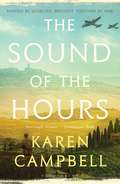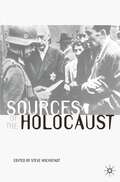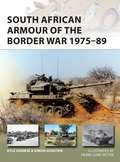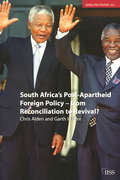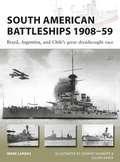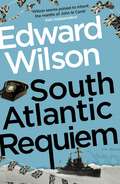- Table View
- List View
Sopwith Camel (Air Vanguard #3)
by Peter Bull Richard Chasemore Simon Smith Jon Guttman Harry DempseyAn icon of World War I aerial combat, the Sopwith Camel was a superb dogfighter in the hands of a pilot who could master its vicious idiosyncrasies. The first British fighter to be armed with twin machine guns, the Camel packed a considerable punch and was highly successful, notching up a considerable number of aerial victories. The Camel was a remarkable aircraft, and one that could perform in a variety of roles, including as a ground strafer, a night fighter and a carrier-based fighter. As newer, higher performance aircraft types were introduced and began to eclipse it, the dominance of the Camel declined and losses mounted. Nevertheless, Camels appeared over battlefields throughout the war and beyond, notably in the Russian Civil War.
Sopwith Pup Aces of World War 1 (Aircraft of the Aces)
by Norman Franks Harry DempseyThe Sopwith Pup was the forerunner of the hugely successful Sopwith Camel, which duly became the most successful fighter of World War 1. The first proper British fighting scout, the first Pups – the Royal Naval Air Service – arrived on the Western Front in 1916. Although regarded as a 'nice' aeroplane to fly, pilots who used it in combat gained much success during the first half of 1917. The Royal Flying Corps also used the Pup from January 1917 onwards, with the final combats with the machine occurring in December of that year. This book describes the combat careers of the successful Pup aces, how they flew and how they fought.
Sopwith Pup Aces of World War 1 (Aircraft of the Aces #67)
by Norman Franks Harry DempseyThe Sopwith Pup was the forerunner of the hugely successful Sopwith Camel, which duly became the most successful fighter of World War 1. The first proper British fighting scout, the first Pups – the Royal Naval Air Service – arrived on the Western Front in 1916. Although regarded as a 'nice' aeroplane to fly, pilots who used it in combat gained much success during the first half of 1917. The Royal Flying Corps also used the Pup from January 1917 onwards, with the final combats with the machine occurring in December of that year. This book describes the combat careers of the successful Pup aces, how they flew and how they fought.
The Sorrow Of War: A Novel Of North Vietnam
by Bao NinhKien’s job is to search the Jungle of Screaming Souls for corpses. He knows the area well – this was where, in the dry season of 1969, his battalion was obliterated by American napalm and helicopter gunfire. Kien was one of only ten survivors. This book is his attempt to understand the eleven years of his life he gave to a senseless war. Based on true experiences of Bao Ninh and banned by the communist party, this novel is revered as the ‘All Quiet on the Western Front for our era’.
Sorties into Hell: The Hidden War on Chichi Jima (Non-ser.)
by Chester G. HearnIn October 1946, Colonel Presley Rixey arrived by destroyer at Chichi Jima to repatriate 22,000 Japanese who had been bypassed during the war in the Pacific. While waiting for a Marine battalion to arrive, the colonel met daily with a Japanese commission assigned to assist him. When asked what had happened to American prisoners on the island, the Japanese hatched a story to hide the atrocities that they had committed. In truth, the downed flyers had been captured, executed, and eaten by certain senior Japanese officers. This is the story of the investigation, the cover-up, and the last hours of those Americans who disappeared into war's wilderness and whose remains were distributed to the cooking galleys of Chichi Jima.Rixey's suspicion of a cover-up was later substantiated by a group of Americans returning from Japan who had lived on Chichi Jima for generations. It would take five months of gathering testimony to uncover all the details. Thirty war criminals were eventually tried at Guam in 1947, five of whom met their fate on the gallows.
The Soul Of A Thief (Hq Digital Ser.)
by Steven HartovIn the spring of 1944, I realized that I was not going to survive the war…
The Soul of Armies: Counterinsurgency Doctrine and Military Culture in the US and UK (Cornell Studies in Security Affairs)
by Austin LongFor both the United States and United Kingdom counterinsurgency was a serious component of security policy during the Cold War and, along with counterterrorism, has been the greatest security challenge after September 11, 2001. In The Soul of Armies, Austin Long compares and contrasts counterinsurgency operations during the Cold War and in recent years by three organizations: the US Army, the US Marine Corps, and the British Army. Long argues that the formative experiences of these three organizations as they professionalized in the nineteenth century has produced distinctive organizational cultures that shape operations. Combining archival research on counterinsurgency campaigns in Vietnam and Kenya with the author’s personal experience as a civilian advisor to the military in Iraq and Afghanistan, The Soul of Armies demonstrates that the US Army has persistently conducted counterinsurgency operations in a very different way from either the US Marine Corps or the British Army. These differences in conduct have serious consequences, affecting the likelihood of success, the potential for civilian casualties and collateral damage, and the ability to effectively support host nation governments. Long concludes counterinsurgency operations are at best only a partial explanation for success or failure.
The Sound of a Thousand Stars: An absolutely heartbreaking and gripping World War 2 novel inspired by a true story
by Rachel Robbins'An amazing story of love and The Manhattan Project that is both sad and triumphant... haunting and magnificent' Reader review ⭐⭐⭐⭐⭐1944, New Mexico: Alice Katz is a young Jewish physicist, one of the only female doctoral students at her university, studying with the famous Dr Oppenheimer. Her well-to-do family wants her to marry and settle down. Instead, Alice answers her country's call to go deep into the desert and lend her skills to a secret project at the heart of the fight against Germany. At Los Alamos, Alice meets Caleb, who has been assigned to the explosives division. Around them are other young scientists and engineers who have left their ordinary lives behind, telling no one where they are going and what they will be doing. Details of the project are shrouded in secrecy, but everyone knows it is a race against time to beat the Nazis before they create an unspeakable weapon of their own.In this atmosphere of fear and uncertainty, and despite their many differences, Alice and Caleb find themselves drawn to one another. But as they become more and more desperate to complete their mission before the war is lost, they will face a heartbreaking choice between love for their country and love for each other... This epic tale of love in the face of war is a poignant reminder of the consequences of our decisions, and the roles we play in history. Perfect for fans of Oppenheimer, Hidden Figures and The Diamond Eye. Everyone loves The Sound of a Thousand Stars:'Meticulously researched and beautifully rendered... Reminds us that the greatest mysteries are those of the human heart. This book will leave you breathless' Soon Wiley'A soaring testament to all those unseen souls who answered history's call and selflessly sacrificed in order to shape the world in which we live' Giano Cromley'Asks devastating questions of our past while engaging in hopeful reflections on love. The attention to historical and scientific detail is impressive, and the prose kept me turning pages' Reader review ⭐⭐⭐⭐⭐'Riveting story that shows love and destiny are forces just as powerful as faith or science' Kathleen Rooney'Beautifully done historical fiction... It had everything that I was looking for... I enjoyed the science element' Reader review ⭐⭐⭐⭐⭐'Asking questions of complicity and sacrifice that reverberate today, this beautifully written novel considers the costs of scientific advancement, the value of an individual life, and the thrilling knife's edge of being in love' Julia Fine
The Sound of the Hours
by Karen CampbellDivided by loyalties, brought together by warSeptember, 1943. Tuscany, Italy. In the hilltop town of Barga, everyone holds their breath. Even the bells fall silent. Everything Vittoria Guidi knows and loves is at risk. German troops occupy the mountains around her home, as America's Buffalo Soldiers prepare to invade. As Vittoria's country is torn in two, so is her conscience. Should she side with her Scots-Italian father or her Fascist mother? Should she do what she is told – or what she believes in?Frank Chapel, a young, black American soldier fighting with the Buffalo soldiers for a country that refuses him the vote, is unlike anyone Vittoria has ever met. In the chaos, they find each other – but can their growing love overcome prejudice and war?
The Sources of Military Doctrine: France, Britain, and Germany Between the World Wars (Cornell Studies in Security Affairs)
by Barry R. PosenBarry R. Posen explores how military doctrine takes shape and the role it plays in grand strategy-that collection of military, economic, and political means and ends with which a state attempts to achieve security. Posen isolates three crucial elements of a given strategic doctrine: its offensive, defensive, or deterrent characteristics, its integration of military resources with political aims, and the degree of military or operational innovation it contains. He then examines these components of doctrine from the perspectives of organization theory and balance of power theory, taking into account the influence of technology and geography.Looking at interwar France, Britain, and Germany, Posen challenges each theory to explain the German Blitzkrieg, the British air defense system, and the French Army's defensive doctrine often associated with the Maginot Line. This rigorous comparative study, in which the balance of power theory emerges as the more useful, not only allows us to discover important implications for the study of national strategy today, but also serves to sharpen our understanding of the origins of World War II.
Sources of the Holocaust (Documents in History)
by Steve HochstadtThe Holocaust was the central event of the twentieth century. How can we understand the Nazi drive to murder millions of people, or the determination of concentration camp prisoners to survive? In this new collection of original documents and sources, Steve Hochstadt brings the reader into direct contact with the Holocaust's human participants. The words of Nazi leaders and common soldiers, SS doctors and European collaborators show how and why they became involved in mass murder, while those of the victims help us to imagine their torments.Sources of the Holocaust moves from the origins of Christian anti-Semitism to today's controversies over restitution to reveal the ideas that made the Holocaust possible, the detailed Nazi plans to destroy human lives, and the ability of those targeted to mount resistance. Hochstadt's authoritative commentaries on each source, based on the latest research, describe the people who produced these documents, and provide a full history of the Holocaust. At the same time, Hochstadt offers fresh ideas on major perpetrators, the significance of resistance, and the meaning of the word 'Holocaust'.Both shocking and compelling, this volume of authentic accounts of Holocaust experiences offers new insights into one of the most terrible episodes in human history.
Sousveillance, Media and Strategic Political Communication: Iraq, USA, UK
by Vian BakirFusing perspectives from politics, media studies and cultural studies, Sousveillance, Media and Strategic Political Communication offers insights into impacts on strategic political communication of the emergence of web-based participatory media ('Web 2.0') across the first decade of the 21st century. Countering the control engendered in strategic political communication, Steve Mann's concepts of hierarchical sousveillance (politically motivated watching of the institutional watchers) and personal sousveillance (apolitical, human-centred life-sharing) is applied to Web 2.0. Focusing on interplays of user-generated and mainstream media about, and from, Iraq, detailed case studies explore different levels of control over strategic political communication during key moments, including the start of the 2003 Iraq war, the 2004 Abu Ghraib scandal, and Saddam Hussein's execution in 2006. These are contextualized by overviews of political and media environments from 2001-09. Dr Bakir outlines broader implications of sousveillant web-based participatory media for strategic political communication, exploring issues of agenda-building, control, and the cycle of emergence, resistance and reincorporation of Web 2.0. Sousveillance cultures are explored, delineating issues of anonymity, semi-permanence, instanteneity resistance and social change.
South Africa and the Communist International: Volume 1: Socialist Pilgrims to Bolshevik Footsoldiers, 1919-1930
by Alexander O. ChubariyanThis is a comprehensive selection of documents pertaining to the Communist Party of South Africa from the formerly closed archives of the Communist International.
South Africa and the Communist International: Volume 1: Socialist Pilgrims to Bolshevik Footsoldiers, 1919-1930
by Apollon B. Davidson Irina Filatova Valentin P. Gorodnov Sheridan JohnsThis is a comprehensive selection of documents pertaining to the Communist Party of South Africa from the formerly closed archives of the Communist International.
South African Armour of the Border War 1975–89 (New Vanguard)
by Simon Dunstan Kyle Harmse Pierre Lowe VictorThe Border War saw the biggest armoured battles in Africa since World War II. Starting as a counter-insurgency operation by the South African Defence Force (SADF) against the South West Africa People's Organisation, South Africa became embroiled in the complex Angolan Civil War, where they came up against enemies well supplied with equipment and armoured vehicles from the Soviet Union. With the aid of stunning illustrations and photographs, this study details the characteristics, capabilities and performance of the wide variety of armoured vehicles deployed by the SADF, from the Eland armoured car to the Ratel infantry combat vehicle and the Olifant tank. Designed for the unique conditions of the region, South Africa's armour was distinctive and innovative, and has influenced the design of counterinsurgency armoured vehicles around the world.Frequently requested by Osprey readers, and written by two renowned experts on armoured vehicles, this will appeal to all those interested in modern armour and the Cold War proxy wars.
South African Armour of the Border War 1975–89 (New Vanguard #243)
by Simon Dunstan Kyle Harmse Pierre Lowe VictorThe Border War saw the biggest armoured battles in Africa since World War II. Starting as a counter-insurgency operation by the South African Defence Force (SADF) against the South West Africa People's Organisation, South Africa became embroiled in the complex Angolan Civil War, where they came up against enemies well supplied with equipment and armoured vehicles from the Soviet Union. With the aid of stunning illustrations and photographs, this study details the characteristics, capabilities and performance of the wide variety of armoured vehicles deployed by the SADF, from the Eland armoured car to the Ratel infantry combat vehicle and the Olifant tank. Designed for the unique conditions of the region, South Africa's armour was distinctive and innovative, and has influenced the design of counterinsurgency armoured vehicles around the world.Frequently requested by Osprey readers, and written by two renowned experts on armoured vehicles, this will appeal to all those interested in modern armour and the Cold War proxy wars.
South African Special Forces (Elite #47)
by Robert Pitta Simon McCouaigThis book provides a highly detailed account of the history, organisation, uniforms and insignia of South African Special Forces from their origins up to the early 90s – units such as the 44 Parachute Brigade, the Hunter Group and the infamous SWA Police COIN Unit 'Koevoet'. These elite units of the South African Defence Force and the special anti-terrorist units of the South African Police Forces comprised the largest, best trained and best equipped of any country in southern Africa. Robert Pitta and Jeff Fannell provide the text in a volume packed with photographs and illustrations.
South African Special Forces (Elite #47)
by Robert Pitta Simon McCouaigThis book provides a highly detailed account of the history, organisation, uniforms and insignia of South African Special Forces from their origins up to the early 90s – units such as the 44 Parachute Brigade, the Hunter Group and the infamous SWA Police COIN Unit 'Koevoet'. These elite units of the South African Defence Force and the special anti-terrorist units of the South African Police Forces comprised the largest, best trained and best equipped of any country in southern Africa. Robert Pitta and Jeff Fannell provide the text in a volume packed with photographs and illustrations.
South Africa's 'Border War': Contested Narratives and Conflicting Memories (War, Culture and Society)
by Gary BainesSouth Africa's 'Border War' provides a timely study of the 'war of words' waged by retired South African Defence Force (SADF) generals and other veterans against critics and detractors. The book explores the impact of the 'Border War' on South African culture and society during apartheid and in the new dispensation and discusses the lasting legacy or 'afterlife' of the war in great detail. It also offers an appraisal of the secondary literature of the 'Border War', supplemented by archival research, interviews and an analysis of articles, newspaper reports, reviews and blogs.Adopting a genuinely multidisciplinary approach that borrows from the study of history, literature, visual culture, memory, politics and international relations, South Africa's 'Border War' is an important volume for anyone interested in the study of war and memory or the modern history of South Africa.
South Africa's 'Border War': Contested Narratives and Conflicting Memories (War, Culture and Society)
by Gary BainesSouth Africa's 'Border War' provides a timely study of the 'war of words' waged by retired South African Defence Force (SADF) generals and other veterans against critics and detractors. The book explores the impact of the 'Border War' on South African culture and society during apartheid and in the new dispensation and discusses the lasting legacy or 'afterlife' of the war in great detail. It also offers an appraisal of the secondary literature of the 'Border War', supplemented by archival research, interviews and an analysis of articles, newspaper reports, reviews and blogs.Adopting a genuinely multidisciplinary approach that borrows from the study of history, literature, visual culture, memory, politics and international relations, South Africa's 'Border War' is an important volume for anyone interested in the study of war and memory or the modern history of South Africa.
South Africa's Post Apartheid Foreign Policy: From Reconciliation to Revival? (Adelphi series)
by Chris AldenThe book presents and analyses South African foreign policy, from the onset of the democratic transition of Nelson Mandela in 1994 to the contemporary period. The focus of the study is on the question of South African leadership in the context of this transition.
South Africa's Post Apartheid Foreign Policy: From Reconciliation to Revival? (Adelphi series)
by Chris AldenThe book presents and analyses South African foreign policy, from the onset of the democratic transition of Nelson Mandela in 1994 to the contemporary period. The focus of the study is on the question of South African leadership in the context of this transition.
South American Battleships 1908–59: Brazil, Argentina, and Chile's great dreadnought race (New Vanguard)
by Mark LardasIn 1908 the most incredible naval arms race in history began. Flush with cash from rubber and coffee, Brazil decided to order three of the latest, greatest category of warship available – the dreadnought battleship. One Brazilian dreadnought by itself could defeat the combined gunnery of every other warship of all the other South American nations. Brazil's decision triggered its neighbour Argentina to order its own brace of dreadnoughts, which in turn forced Chile (which had fought boundary disputes with Argentina) to order some.In the process, the South American dreadnought mania drove the three participants nearly into insolvency, led to the bankruptcy of a major shipyard, and triggered a chain of events which led Turkey to declare war on Great Britain. It also produced several groundbreaking dreadnought designs and one of the world's first aircraft carriers.
South American Battleships 1908–59: Brazil, Argentina, and Chile's great dreadnought race (New Vanguard)
by Johnny Shumate Mark Lardas Julian BakerIn 1908 the most incredible naval arms race in history began. Flush with cash from rubber and coffee, Brazil decided to order three of the latest, greatest category of warship available – the dreadnought battleship. One Brazilian dreadnought by itself could defeat the combined gunnery of every other warship of all the other South American nations. Brazil's decision triggered its neighbour Argentina to order its own brace of dreadnoughts, which in turn forced Chile (which had fought boundary disputes with Argentina) to order some.In the process, the South American dreadnought mania drove the three participants nearly into insolvency, led to the bankruptcy of a major shipyard, and triggered a chain of events which led Turkey to declare war on Great Britain. It also produced several groundbreaking dreadnought designs and one of the world's first aircraft carriers.
South Atlantic Requiem (William Catesby)
by Edward WilsonA brilliant, eye-opening espionage thriller by a former special forces officer 'now at the forefront of spy writing''The thinking person's John le Carré' Tribune 'Edward Wilson seems poised to inherit the mantle of John le Carré' Irish Independent'More George Smiley than James Bond, Catesby will delight those readers looking for less blood and more intelligence in their spy thrillers' Publishers WeeklyIt is 1982 and the British prime minister and the Argentine president are both clinging to power. Downing Street, having ignored alarm bells coming from the South Atlantic, finds itself in a full-blown crisis when Argentina invades the remote and forgotten British territory of the Falklands Islands. Catesby is dispatched urgently to prevent Argentina from obtaining more lethal Exocet missiles by fair means or foul. From Patagonia to Paris, from Chevening to the White House, Catesby plays a deadly game of diplomatic cat and mouse determined to avert the loss of life. The clock is ticking as diplomats and statesmen race for a last-minute settlement while the weapons of war are primed and aimed. Edward Wilson's stunning new spy thriller brilliantly evokes the intricate world of high-stakes espionage with a rare authenticity and deeply-felt sympathy for the human cost and tragedy of conflict.'Gets nearer to the truth of what happened in the Falklands War than any of the standard histories. Highly recommended' Clive Ponting'A classic of the genre . . . as good as espionage thriller writing gets' NB Magazine'A stunning and ingenious book' Crime ReviewPraise for Edward Wilson:'Stylistically sophisticated . . . Wilson knows how to hold the reader's attention' W.G. Sebald'A reader is really privileged to come across something like this' Alan Sillitoe'All too often, amid the glitzy gadgetry of the spy thriller, all the fast cars and sexual adventures, we lose sight of the essential seriousness of what is at stake. John le Carré reminds us, often, and so does Edward Wilson' Independent



